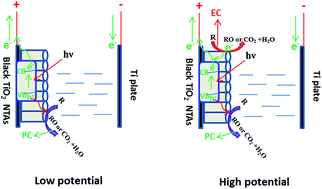Black TiO2 nanotube arrays fabricated by electrochemical self-doping and their photoelectrochemical performance
Abstract
Herein, black TiO2 nanotube arrays (NTAs) were fabricated using electrochemical self-doping approaches, and characterized systemically by scanning electron microscopy (SEM), powder X-ray diffraction (XRD), UV-visible absorption spectroscopy and photoluminescence spectroscopy (PL). The as-obtained black TiO2 nanotube arrays (NTAs) exhibited stronger absorption in the visible-light region, a better separation rate of light-induced carriers, and higher electrical conductivity than TiO2 nanotube arrays (NTAs). These characteristics cause black TiO2 nanotube array (NTA) electrodes to have higher photoelectrocatalytic activity for degrading anthraquinone dye (reactive brilliant blue KN-R) than the TiO2 nanotube array (NTA) electrode. Furthermore, a synergetic action between photocatalysis and electrocatalysis was also observed. The black TiO2 nanotube array (NTA) electrode is considered to be a promising photoanode for the treatment of organic pollutants.



 Please wait while we load your content...
Please wait while we load your content...